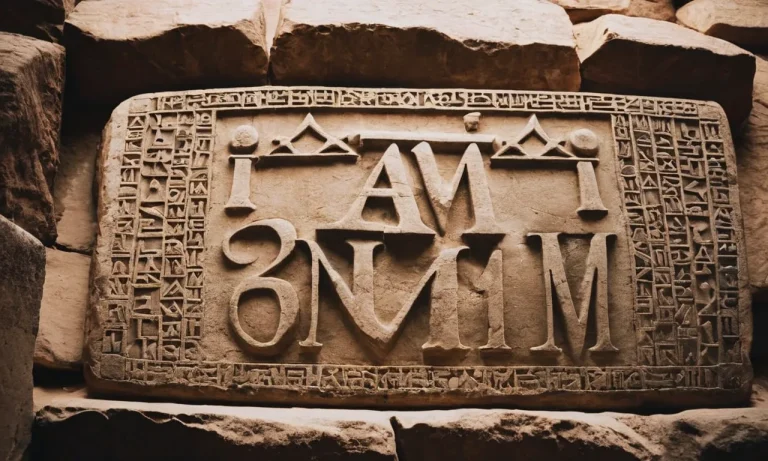How Tall Was Og In The Bible?
The giant Og is briefly mentioned in the Bible as one of the few surviving Rephaim, a race of giants who lived in Canaan before the Israelites conquered the land. Though his height is not given explicitly, there are clues that suggest Og was an extraordinarily tall man.
If you’re short on time, here’s a quick answer to your question: based on various textual clues, many biblical scholars estimate Og to have been around 9 feet tall.
The Rephaim Were Known for Their Great Height
The Rephaim were a mysterious group of giants mentioned several times in the Old Testament. Though not much is known about their origins, they were renowned for their immense stature and imposing appearance.
The word “Rephaim” means “giants” in Hebrew. They were closely associated with the Anakim, another group of giants living in the Promised Land. The Anakim were descendants of the Nephilim, the offspring of the “sons of God” and human women according to Genesis 6:4.
It’s possible the Rephaim shared a similar ancestry.
The Rephaim were first mentioned as living east of the Jordan River alongside the Emim and Zamzummim, other giant clans (Deuteronomy 2:20-21). When Moses sent spies to scout out the Promised Land, they reported back that “the land devours its inhabitants; all the people we saw there are of great size… We seemed like grasshoppers in our own eyes, and we looked the same to them” (Numbers 13:32-33).
One of the Rephaim was Og, king of Bashan. According to Deuteronomy 3:11, “his bed was made of iron and was more than thirteen feet long and six feet wide.” If Og’s bed was custom-made for his stature, he may have been over 13 feet tall!
The Rephaim king Og and his army were defeated by Moses and the Israelites as they conquered territories east of the Jordan (Deuteronomy 3:1-3).
Later during the time of Joshua’s conquest of Canaan, the Rephaim were living in southwestern Israel in the region of Ashtaroth. Under the leadership of King Og, they joined a coalition of Canaanite kings to wage war against the invading Israelites.
However, Joshua and the Israelites were victorious against them in battle and destroyed the Rephaim cities (Joshua 12:4).
Other references to the Rephaim appear in poetic passages. Job 26:5-6 mentions “the shades below tremble, the waters and their inhabitants. Sheol is naked before God, and Abaddon has no covering.” Here the Rephaim seem to be linked with the afterlife.
Isaiah 14:9 pictures Sheol trembling to meet the king of Babylon, “rousing the shades to greet you.” And Proverbs 2:18 warns against the adulteress “For her house sinks down to death, and her paths to the shades.”
Though mysterious in origin, the Rephaim left a lasting impression in the Old Testament as formidable giants of the antediluvian age. Their gigantic stature made them feared warriors. But they were ultimately no match for the conquering Israelites under the mandate of God.
The intriguing references to the Rephaim fascinate Bible scholars even today.
Og Was the Last of the Remnant of the Rephaim
The biblical figure Og was the last surviving member of an ancient race of giants known as the Rephaim. Though details about Og are scarce in Scripture, he is mentioned in several key passages that give us clues about his origins and ultimate fate.
The Rephaim Were a Race of Giants
The first mention of the Rephaim comes in Genesis 14, where they are described as inhabiting the region around the Dead Sea in the time of Abraham. The term “Rephaim” refers to ancient mythological beings who were viewed as primordial giants and inhabitants of the underworld.
The Old Testament employs this term for a race of literal giants who lived in Canaan prior to the Israelite conquest of the land under Joshua.
Og was called “the last of the remnant of the Rephaim” (Deuteronomy 3:11). This indicates he belonged to a dwindling race facing extinction. The Rephaim are also referenced in other books of the Old Testament as belonging to tribes and kingdoms defeated by the Israelites as they took possession of Canaan (Joshua 12:4, 13:12; 2 Samuel 5:18, 22).
Og Was a Giant King in Bashan
The first mention of Og personally comes in Deuteronomy 3:1-3, where he is called the king of Bashan. Bashan was a region located east of the Jordan River and north of the Yarmouk River in what is now southern Syria and northern Jordan. Og ruled over 60 walled cities from his capital of Ashtaroth.
As the Israelites under Moses were approaching Canaan from the east after their wilderness wanderings, they defeated Og and his army in battle at Edrei and took possession of his territory (Deuteronomy 3:3-4). This victory is also mentioned briefly in Numbers 21:33-35.
Og Was of Legendary Stature
One of the most intriguing facts highlighted about Og is his immense size. Deuteronomy 3:11 states that his bedstead (or coffin) was made of iron and measured over 13 feet long and 6 feet wide. Based on this huge bed, Og himself may have been around 12 feet tall or even larger.
To put this in perspective, the average height of an NBA player today is just under 7 feet. So Og was possibly twice as tall as today’s tallest basketball players! His towering height adds credence to the idea that he was one of the last of a dwindling race of giants occupying Canaan.
| Ancient Giants | Average Height |
|---|---|
| Og of Bashan | Over 12 feet |
| Goliath of Gath | Over 9 feet |
| Anakim | 7-9 feet |
This table compares the legendary stature of biblical giants Og, Goliath, and the Anakim versus average modern human height.
Og’s Legacy as a Giant King
Though lacking in details, the Bible presents Og as a formidable giant king whose conquest demonstrated God’s power and fulfilled prophecy about dispossessing the ancient Canaanite nations (see Deuteronomy 20:16-18).
His enormous size became legendary as a testament to the literal giants who occupied the land prior to the Israelites.
Og’s gigantism may have been the result of genetic disorders passed down in Nephilim/Rephaim ancestry, though this is speculative. His appearance in multiple books of the Bible prove Og was no mythical figure but a real person of renown in ancient lore.
As the last verifiable member of the Rephaim, Og’s death marked the end of an ancient pre-Israelite, giant-led civilization in the Transjordan region. His larger-than-life attributes Stir the imagination and serve as a window into the mysterious early periods of Old Testament history.
Og’s Bed Measured Over 13 Feet Long
The Bible references a giant named Og who was the king of Bashan. One passage specifically mentions the enormous size of his bed, stating that it was 13.5 feet long and 6 feet wide (Deuteronomy 3:11). This has led many to conclude that Og must have been an incredibly large man if he required such an enormous bed.
There are a few key things to understand about this passage:
- The bed was made of iron – This indicates it was a ceremonial or symbolic bed, not a regular sleeping bed. Kings often had oversized beds as a sign of power and prestige.
- The dimensions were approximate – The phrase “according to the cubit of a man” suggests these were rough estimates, not precise measurements.
- “Bed” could refer to other furniture – The Hebrew word “eress” translated as “bed” may have referred to other types of furniture like a sarcophagus or couch.
So while Og was surely a large man, the dimensions of his “bed” don’t necessarily tell us his exact height. Ancient kings often exaggerated their power and influence, so this was likely meant to evoke ideas of Og’s might and stature, not give precise specifications.
That said, other clues in the Bible paint Og as a formidable giant:
- He was from the remnant of the Rephaim, a people known for their great size.
- His kingdom of Bashan was known for its oaks, implying a large territory only a giant could rule.
- He was defeated by Moses and the Israelites, reinforcing the idea he was a threatening giant.
Later Jewish Tradition Portrayed Og as Even Taller
In the centuries after the Old Testament was written, Jewish rabbis and scholars expanded on the brief biblical accounts of Og. In their retellings, Og grew to gigantic proportions. According to the 3rd century AD compilation the Talmud, Og’s bed was nine cubits long – around 13 or 14 feet, assuming a cubit of 18 inches.
Some later commentators claimed Og himself must have been at least 30 or 40 feet tall if his bed was this enormous.
References to Og’s great stature abound in Jewish literature. The medieval Jewish writer Rashi claimed Og was 500 cubits tall – around 750 feet. Other accounts also portrayed Og as hundreds of feet tall.
While these later traditions obviously exaggerated biblical accounts, they show how Og’s reputation as a giant grew over time.
Why did Jewish writers keep making Og taller and taller? Most likely because it made him more frightening and awe-inspiring as an enemy of God’s people. For Jews reading these accounts, it reinforced God’s power and their status as the chosen nation that He protected.
Making their enemies – like Og and the other Canaanite kings – seem like gigantic, towering monsters highlighted God’s ability to defeat them.
Some details added to Og’s legend also symbolized his evilness and opposition to God. Jewish texts described Og as surviving the Flood in Noah’s day by clinging to the outside of the Ark. One account claims Og was the offspring of angels who had fallen from heaven, linking him with demonic forces.
So in later Judaism, Og evolved from being simply an enemy king of Bashan into a primordial giant and enemy of God, a terrifying bogeyman figure. His height became hyperbolic, underscoring the power and providence of the God of Israel.
But the core idea of Og as a remnant of an ancient race of giants remained.
Conclusion
Though the Bible does not explicitly state Og’s height, analysis of the textual clues suggests he was considered exceptionally large, even for a descendant of the giant Rephaim. Estimates range from 9 feet tall to even taller in later Jewish tradition.
Whatever his true dimensions, Og remains one of the most famously towering figures of the Old Testament.








